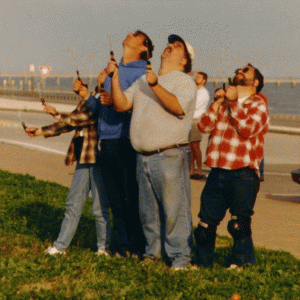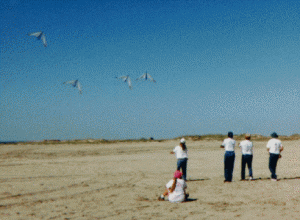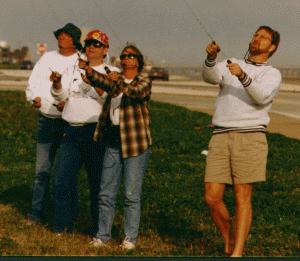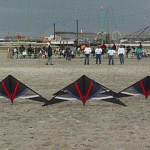How to start a Kite Team…or maybe not?
The history of the Austin End Of the Line Kite Team
If you’ve never flown on a team and maybe don’t think you are good enough, this article is for you. If you are an experienced flier, looking for a definitive article on forming a kite team read no further, unless you have a good sense of humor!
This is a story about how our kite team was formed. We saw our first team performance at the Blue Bonnet Kite Festival in San Marcos, Texas in April 1996. Team TKO absolutely dazzled us. We decided that we just had to try it, so on that day we formed a kite team. Our experience at flying kites was minimal. I was the veteran, this was my second novice competition and I had been flying kites for 9 months. The next most experienced flier had 6 months experience and the remaining 2 members of the team each had one month of kite flying experience.
At this point you should realize that if we can do it, anybody can. Our first team activity was a demo at a “take your child to work day” function. All we did was individually fly kites and let people try them. It was a fun start just to see the excitement in the eyes of the kids in attendance. Immediately after the event I posted to rec.kites “What a Rush!” and signed it with “The team with no name yet”. That article generated a lot of encouragement and comments that we really should use “The Team With No Name” as our identity. We didn’t and after discussion we decided on Austin End Of the Line Kite Team (EOL). The name is a play on EOL or “End Of Line” character in old computer lingo that also fit kite flying.We wanted to use the name of our hometown so people would realize where we are from. After looking at our team we realized that “End Of the Line” was fitting, not front of the line, or head of the line but the tail end. We could be last at events and just chuckle that it fit our team name.
The first practice we had, we couldn’t even get all 4 kites in the air at the same time. When we did manage to get them launched and the lines touched for the first time panic set in. The crash was immediate and the tangles were horrible. In the early months we spent more time untangling lines than flying kites, but we had a ball, laughing all the while. Eventually we got to follow the leader in an infinity. We’d run up on each other, panic and crash. Twisted lines revisited. We were the blind leading the blind. We tried to tune our kites. We still had no real success, a hint, it took us another 6 months or so to realize that we couldn’t stand flat footed, SHOCK, speed control, what is that???? We practiced every weekend and saw some progress, enough to keep on trying.
 We read a post in rec.kites by Carolyn Weir of Galveston mentioning Team and Pairs lessons. We made contact and in mid August 1996 we went. When we got there we were surprised to find our visit advertised at the local kite shop, Kites Unlimited. We were in a panic, afraid of what people would expect. We had 6 things we could do as a team, an infinity, ladder up and down, 2 loops to the right and then to the left, a split loop on the diagonals of the infinity, a burst, and horizontal threads. That was it, and none of those looked very clean. The kite fliers in Galveston were very friendly and made us feel at home. The encouragement they offered was priceless. They made us feel on top of the world. We were even brave enough or foolish enough to try a team night fly that evening. The crowd couldn’t believe what we were going to attempt. That night, with the steady coastal breeze and not being able to see the lines, we amazed ourselves. We flew better than we had in the daylight. For some reason, not being able to see the lines helped us relax and concentrate on the kites. From that day on Galveston TX has been like a second home to us.
We read a post in rec.kites by Carolyn Weir of Galveston mentioning Team and Pairs lessons. We made contact and in mid August 1996 we went. When we got there we were surprised to find our visit advertised at the local kite shop, Kites Unlimited. We were in a panic, afraid of what people would expect. We had 6 things we could do as a team, an infinity, ladder up and down, 2 loops to the right and then to the left, a split loop on the diagonals of the infinity, a burst, and horizontal threads. That was it, and none of those looked very clean. The kite fliers in Galveston were very friendly and made us feel at home. The encouragement they offered was priceless. They made us feel on top of the world. We were even brave enough or foolish enough to try a team night fly that evening. The crowd couldn’t believe what we were going to attempt. That night, with the steady coastal breeze and not being able to see the lines, we amazed ourselves. We flew better than we had in the daylight. For some reason, not being able to see the lines helped us relax and concentrate on the kites. From that day on Galveston TX has been like a second home to us.
About this time a long distance friendship was developed with Mike Gillard of Captain Eddie’s Flying Circus over the Internet. Mike took us under his wing and offered us encouragement AND a set of their old lines. To have a set of 300#, 150# and 80# lines already made up was a fabulous gift. They were well used but functional; they have since been passed on to another team starting up. We were flying Aerie Kiteworks Sabres, almost unbreakable and relatively inexpensive. As time passed, Mike offered to sell us their team’s used Air FX’s, a deal we couldn’t pass up. They arrived and opened up more practice time since they flew in lighter winds. We prepared for our first competition in South Padre Island, Texas, in November 1996.
 For two members of our team, this was their first time to compete, individually as well as team. Overall we did well, but our team flying was shall we say, not of the highest caliber but the crowds appreciated our effort. We still had very few moves and no routine. We just flew and hoped for the best. One thing we have found out after a year of competition, the crowds are amazed at team kite flying. No matter how poorly you think you are doing, there will always be people that think you are the best. Accept the encouragement and the good wishes. Do not sell yourselves short. We didn’t realize it but Kevin, our current #4, saw us for the first time at this event and was impressed. So, no matter what, don’t give up. Keep on trying and making friends. South Padre Island has become one of our home away from home cities.
For two members of our team, this was their first time to compete, individually as well as team. Overall we did well, but our team flying was shall we say, not of the highest caliber but the crowds appreciated our effort. We still had very few moves and no routine. We just flew and hoped for the best. One thing we have found out after a year of competition, the crowds are amazed at team kite flying. No matter how poorly you think you are doing, there will always be people that think you are the best. Accept the encouragement and the good wishes. Do not sell yourselves short. We didn’t realize it but Kevin, our current #4, saw us for the first time at this event and was impressed. So, no matter what, don’t give up. Keep on trying and making friends. South Padre Island has become one of our home away from home cities.
After South Padre Island we went back home to Austin and continued to practice for our next competition. We hit one of our many plateaus. We could fly the shapes but our lines were not straight, spacing still needed a lot of work. We never seemed to end a pattern at the same time. We looked back at some of the older video and realized we had made a lot of progress. If you start a team, video your early practices and others occasionally throughout your time together. You can easily get frustrated because you cannot see your progress. For us things seemed to move very slowly.
March of 97 at the Zilker Park Kite Festival was our first experience in a mega fly. We had not flown with any other team fliers and were excited about the opportunity. The first time we had all the kites in the air and were heading toward the ground in a nice rectangular formation and a “flank right” was called we realized something was wrong. Our “right” was from the kite’s perspective, i.e. pull right and everybody else was using window direction. Another tangled mess, score one for Austin EOL! From that day on all our calls had to be changed to reflect window direction. Such confusion…!
In April of 1997, we went to the Blue Bonnet Kite Festival in San Marcos, Texas. We still did not have a routine but at least we had a few more moves. Saturday was the Team precision event. We made it through our figures and set up for our freestyle portion. Just a few seconds into our freestyle, two kites collided during a horizontal thread, and the result was thatour #2 kite had two broken leading edges. All Jim Cox could do was just hang there. Most of us chuckled about it and the field director judges helped us relax with their sense of humor. We managed to keep things going and passed our two-minute minimum. Sadly, one member of our team got very upset and walked off the field. We had broken many spars during all our practices and on this day we broke 4 spars. He felt since we were the only team flying experienced precision we should have just flown infinities and not taken any chances. I think his frustration had been building for a long time and this was the final straw. By the end of the day things seemed back to normal and he said he would see us for Sunday’s Team ballet competition.
Sunday arrived and we waited and waited for our #3 flier. Time passed and it was announced that the team competitions would begin in about an hour. The remaining three of us put our heads together and changed a lot of our patterns from 4 to 3 person maneuvers. Our #4 flier, Steven Ploof, had to move to #3 slot and this made everything backwards for him. We went out and flew some, just to get the feel an figured, “Hey, what do we have to loose.” We took the field, once again with no routine at all and off we went. Speed control was still not something we were comfortable with so twice the #2 kite over took and passed the #1 kite. When that happened he quickly did a loop to fall back in between #1 and #3. We did not crash, we survived and celebrated just getting through it. We did not realize what some of the more experienced team fliers thought about our efforts. They came up to us and gave us lots of encouragement because one, we didn’t fly a missing-man routine where everyone flies as if the 4th kite was there, and we didn’t give up. We had fun and it showed. When all was said and done, we were even more surprised that we had taken first in Experienced Team Ballet. We couldn’t believe it. We looked at the video of our performance a week or so later and that loop that #2 did to get back in place looked like it was a planned move. Despite the adversity, that day was a turning point for us. Not only did we gain the respect of many people, we realized that it had to be fun first. If it isn’t fun, why do it? We also recruited our new #4 flier, Kevin Kirkendoll, and we haven’t looked back since. Oh, I forgot to mention, even though Kevin had been flying for several years he had never competed, Jim Cox and I, pushed prodded and poked Kevin into signing up for his first competition. He did pretty well, especially with no preparation. He fit right in!
We had one month to prepare for our final competition of the season. Most of the time was spent introducing Kevin to team flying. He caught on very quickly. We worked on some of our patterns but still we had no routine what so ever. During this period, some days we felt great because we were making strides but at the next practice it was like we had forgotten everything from the week before. The day finally arrived for our first competition with our new member. We were all more than a little nervous and made another of our many mistakes. At the competition we practiced too much. Every spare moment we were out there practicing team stuff and as the day progressed the frustration built so by the time of the event we were wasted and it showed. To cap things off we did it the next day as well. Now we realize if we don’t have a routine before an event we sure aren’t going to have one by practicing at the event. It has made things much more enjoyable to warm up but stay relaxed.
In August of that year we were invited to spend a weekend flying with Troy Gunn. We owe Troy an immense amount of gratitude for that weekend. It was like the fog had lifted. Just being able to listen to how he calls a routine was very helpful. He taught us some of his team’s patterns and let us fly his vented kites. They made a vast amount of difference that day. We learned about 3/4 turns, team leader turns and to make a call immediately after the preceding call is finished to allow every one to mentally digest it before the execution command is called. That was a major key for me and it really helped the rest of the team when I gave them time to act on command rather than react to my panic calls. Thanks again, Troy!
Things really started to fall in place from that point on. We practiced what Troy had taught us and worked on a routine. We wanted a routine with limited follows and no repeated maneuvers. I was out with my Walkman listening to the music over and over again imagining how the routine would progress. When we got together as a team our sticks and laser pointers got used a bunch as we went through the routine. We never could tune those laser pointers to fly at the pace of the music. Eventually we all had an idea of how things flowed and went off to try in with kites. By this time of the year the wind in Austin is practically non-existent. We never seemed to have enough wind to make it all the way through the routine so we practiced it in segments. As we headed for nationals we still had not flown our routine all the way through without crashing.
At the Nationals we got to meet some of the other experienced class teams. They were great. We compared notes and all were at basically the same level. Lots of crashes, no real confidence and minimal routines. We felt at home and were just excited to be there. The support of the other teams was great. The day came for Experienced Team events and our first was Precision. We were all nervous and still had not flown our routine without crashing somewhere in it. We did our first precision figure and it went okay. We set up for our second precision figure, called in and it went okay. About that time the field director came up and said, “The judges weren’t ready.” Since we hadn’t flown in a competition since May I had forgotten that I needed to wait until the judges were ready, oh well! Repeat the figure! As fearless leader, halfway through, I forgot which one we were doing and really messed it up. Here you must understand the great guys I fly with. There was no yelling or screaming or dirty looks or anything. They understood we all have made mistakes and just move on. Thank you Teammates! We all regrouped and did our final precision figure. Now for the freestyle. We had decided before our departure for Wildwood that we would go for broke. No pulling back to be safe, just an all out shot. We set up and off we went. We survived our launch that had caused us the most problems and continued. We had a few spacing problems but in the end we had completed it without a crash or a tic. We couldn’t believe it!! We were ecstatic on the field, relief… and now to prepare for the ballet. We had to change fields and could not fly our kites from one place to another. One team member was field crewing for the next team up in precision and the ballet pit boss was saying you have to get on the field now! Our #3 flier came running to the field, our field crew came running from the other direction we set up and launched… Do I need to tell you what happened? Just a few seconds into our launch we had a massive tangle and were back on the ground trying to recover. We were on the ground for 37 seconds, relaunched and off we went again. It was erratic but we survived. We were disappointed but thankful that we had made it that far. Once again our team came together. No pointing fingers, no blame just a wish that we could have done better. We did learn one thing. It is more important to do a simple routine that is clean rather than a complex routine and make mistakes.
After we got back home we realized we had lost sight of our goal. We made a very profound decision. We are going to do this for fun! We will improve at our own pace and compete but we were not going to worry about the judges or scores or anything else. We had all decided that our families had to come first so if someone had to miss a practice no problem. That attitude has helped us grow even stronger together and the commitment to the team has grown even more knowing the team will understand if something comes up. We have the support and encouragement of our families, which is priceless to us. Our families come to events with us if they can and are all involved.
 Our next event was back in South Padre Island. One of our team members could not make it so we decided to invite one of our friends to fly with us. Carolyn Weir accepted. She had not flown with us much since she lives 225 miles away but we figured the worst we could do was get last so why not let someone try team. We communicated long distance, sent sketches and a video. We met at the festival and started to work out an on the spot routine. We had a blast, and the excitement in Carolyn’s eyes made it all worth while. Would we bring somebody in again for a comp if a team member couldn’t make it? YOU BETCHA!!!
Our next event was back in South Padre Island. One of our team members could not make it so we decided to invite one of our friends to fly with us. Carolyn Weir accepted. She had not flown with us much since she lives 225 miles away but we figured the worst we could do was get last so why not let someone try team. We communicated long distance, sent sketches and a video. We met at the festival and started to work out an on the spot routine. We had a blast, and the excitement in Carolyn’s eyes made it all worth while. Would we bring somebody in again for a comp if a team member couldn’t make it? YOU BETCHA!!!
As time progressed we got more and more comfortable with our routine. Surprisingly, we also have gotten more trust in flying by the seat of our pants to music just for the fun of it and if an error comes up we just keep on going. Will we ever get to World Cup? Probably not, but you never know. Are we progressing fast? Nope, not really. We feel if we progress at half the speed of other teams we will be doing well. But it fits our goals of making it fun first and keeping the team together. We are just about to complete our season and are looking forward to working on new moves and selecting a new piece of music to fly to. Our team family continues to grow as other kite fliers join us. We continue to invite others to fly with us and currently have the four primary team members and 4 or 5 alternates that we are bringing up to speed slowly. We enjoy sharing the thrill of team flying with others. It helps us see how far we have come and renews our enthusiasm. It also drives home the need for us to practice together to keep our skills up. So many people are in awe of team flying. We try to remove some of the mystery and let people see the beauty and simplicity of even the basics of team flying.
So, what have we learned? Don’t be afraid to start a team. Try to keep it fun. Keep the lines of communication open with your team mates. Make sure the team members’ families feel welcome. If you see a team perform, go up and talk to the members and ask questions. Videotape any team performances you can. Appreciate the audience, they can be very supportive; talk to them and answer questions. You are better than you think! We have had a lot of help and support and to all our friends we say, “Thank You”. If we can answer any of your questions just let us know, and if you see us on the field come by and say, “Howdy!”.



